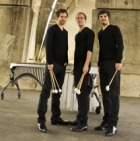Interview,
Bach on the Marimba: Trio SR9
 Something a little off the beaten track - a collection of pieces by JS Bach arranged for perhaps the most unlikely instrument imaginable, the marimba!
Something a little off the beaten track - a collection of pieces by JS Bach arranged for perhaps the most unlikely instrument imaginable, the marimba!
Trio SR9, three marimba-players from France, present a clever selection that works its way through the keys in a great circle, while showing off the surprisingly varied sonorities their instruments can offer. Devotees of historically-informed performance practice might squirm, but it's a delight to listen to and shows Bach's music in a decidedly different light.
I couldn't resist the chance to quiz the trio about their unorthodox take on these hallowed classics.
Your accompanying notes open with an inventory of Bach’s own instrument collection. Clearly he had a great interest in using varied timbres, and the pieces you’ve adapted were originally written for numerous different instruments. Do you think they lose in all being transcribed for the homogeneous forces of the marimba trio, or do they gain something that wasn’t there before?
There is no concept of loss or gain in our artistic proposal. Our work is mainly focused on the spatial distribution of voices, varied timbres and the technical possibilities offered by the marimba. These choices are an angle of attack that is naturally created around a collegial consultation. The advantage of our approach is to show another reading and another readability of this emblematic composer.
Obviously some of this music was written for instruments that can sustain a tone indefinitely, such as the violin and the cello. Did you find that the marimba’s inability to hold long notes constrained your choices of repertoire?
Indeed it is important to pay attention to these technical constraints. The marimba is a percussion instrument, and always asks the question of resonance, whose capacities are induced by the acoustics of the room. It is therefore essential to think about the best way to hold the note like strings or winds, and therefore adapt our game modes using parameters such as tempo, tremolos or phrasing. In the case of this CD, we have selected pieces for strings among the sonatas for violin, the partitas for violin and the cello suites. In these scores, each piece is « playable « with marimba : there is no Cornélian choice.
What led you to choose such a varied selection of movements, rather than, say, one of the books of the Well-Tempered Clavier or the complete Musikalische Opfer?
This program is built around the two Trio Sonatas, representative pieces of our Trio’s approach. We have from there defined the spatial melodic lines, creating a specific "role" to each of us with a soprano voice , a counter-melody and a bass voice. The rest of the program was designed with the idea of varied works in solo, duo or trio and the wish to find a globally and logic rhythm at a time in sound dynamics, in dance styles and in tones, like in a large suite as was done in the Baroque age.
The Canon per tonos recurs several times during this album, forming a kind of musical bridge between the key-areas of the different sections and indeed eventually bringing the tonality full circle back to C. Was this circular feeling part of your conception of the album from the beginning?
On this CD, the program is exactly the same that the program we played in concert many times. The question of a musical bridge and concordant tones was therefore essential because we wished to create a comprehensive and continuous form. The "Canon per tonos" has allowed to create a link between some works and placing the listener in a different state that he used to hear in a more traditional concert where each piece can be cut by audience applause. The choice of tones was essential in the creation of this program, since it also directed the choice of works while creating a perpetual motion in the course of the album. At the beginning we have the introduction in the bass, in C , developing progressively through the 5 octaves of marimba. At the end we have a conclusion in treble, in C again…


